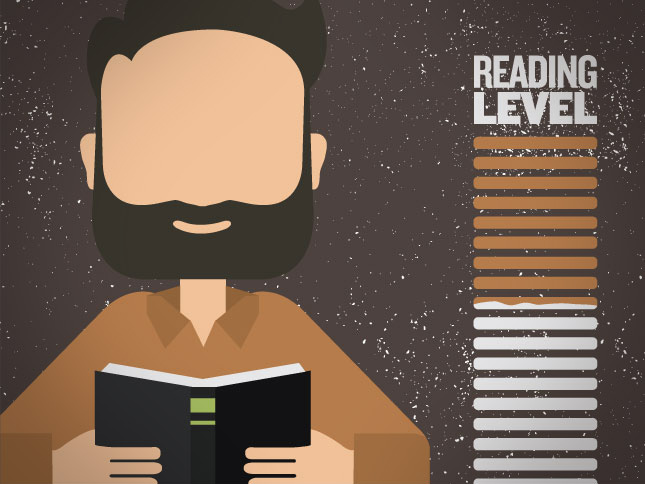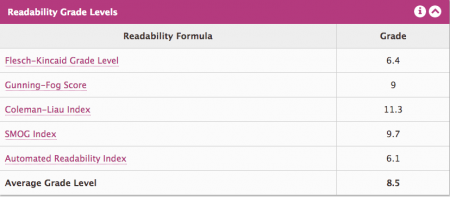Adjust Your Reading Level for a Human Interaction

Even if you’ve gone to college, you probably don’t come across college-level texts in everyday life. A lot of what you read every day is probably at a pretty low reading level. Why? Because most audiences don’t read at a college level, so most writers avoid writing a college level. And most generalized websites aren’t going to write something that their audience can’t understand.
Usually, when we write, we want to reach the broadest audience possible.
What’s your reading level?
The amount of words you use to say what you want, the types of words you use, and the way you combine those words can all change the reading level of your text.
Mental Floss ran a test of some popular blogs to see what reading level their text is catering to. They found some interesting stuff. Hilary Clinton’s blog, for example, is writing at a college level, while Arts & Letters is writing at a middle school level, and the Damn Interesting blog is writing at a genius level. So what’s the sweet spot?
Well, first we should look at what reading level most American adults feel comfortable with, since they will likely make up your audience. According to Huffington post and a study conducted by the U.S. Dept. of Education, “32 million adults in the U.S. can’t read. That’s 14 percent of the population. 21 percent of adults in the U.S. read below a 5th grade level, and 19 percent of high school graduates can’t read.”
So it’s already clear that you probably shouldn’t write at a 12th-grade reading level if 32 million adults can’t even read, right? Let’s take a look at our own score first.

- The Gunning-Fog score is based on the amount of years of formal education a person would need to understand your text. 9 means we are writing at a 9th-grade education level.
- The Coleman-Liau Index is based on characters (not the amount of syllables) found in each word, and the result reflects the grade level, so based on our characters, we’re at a 11.3 grade level.
- SMOG index is supposedly more accurate than the others, according to the Journal of Reading. The SMOG index is based on the number of sentences and the number of syllables in each word. SMOG is used mostly for healthcare materials, and we’re at a 9th-grade reading level there too.
- The Automated Readability Index is like the others. It shows that most 12-year-old readers could understand our blog.
What’s a common reading level?
According to the Readability Score website, the general public reads at an 8th-grade level. It looks like we’re sort of circling right around that sweet spot. There are some other blogs that are following along pretty nicely too!
 Test thanks to http://www.webpagefx.com/tools/read-able/.
Test thanks to http://www.webpagefx.com/tools/read-able/.
So what does an 8th grade reading level look like? Let’s take a peek at an example from The Huffington Post.

Notice anything? How about the types of words used: weird, holy cow, stuff, shows, love…These are all words that everyone can understand. Huffington Post’s writers use common language. Words and phrases like “stuff,” “don’t even” and “a little easy,” make the text feel comfortable and easily understandable. That’s the goal.
Find Your Reading Level
Double check your reading level using one of the programs below.
Readability Score
Online Utility
Adjust Your Reading Level
Once you find your reading level, you may need to make some adjustments. If you’re writing to mass audiences and your writing is at a college level, you may need to simmer down a bit. Some websites have been designed to help you identify your reading level for a curriculum, but if you’re creating text for the general public, you may need to do a bit of work.
The Journal of Extension provides some good tips for writing text for low-literacy and lower-literacy audiences:
- Make your sentences shorter
- Avoid 3-syllable words when possible
- Use bullet points
- Incorporate quality headlines
- Use images when possible
- Place most important text up front
- Use active voice (subject > action > John goes shopping. Passive voice: The shopping was done by John).
- Avoid double negatives
- Avoid synonyms (use the same word when possible)
So go ahead and try out different tactics. See what works and what doesn’t. And when in doubt, write like you’re talking to someone’s grandma. Even if the concepts are complicated, the language doesn’t have to be.